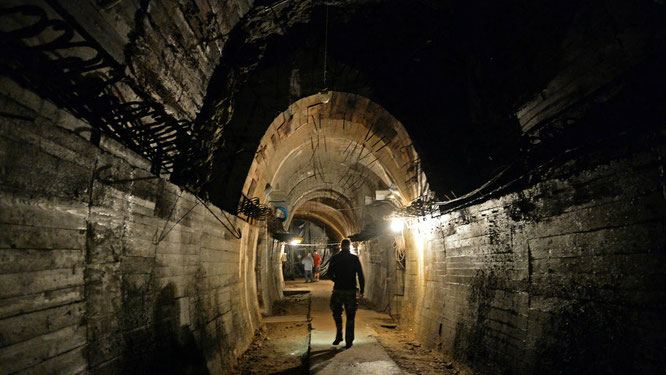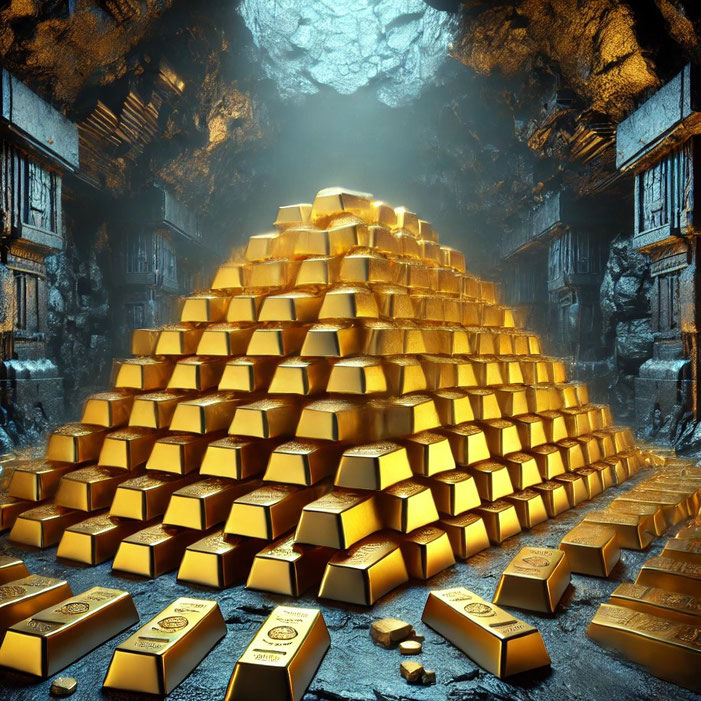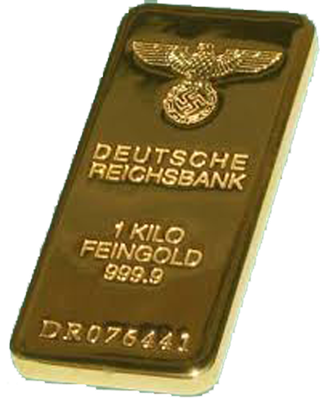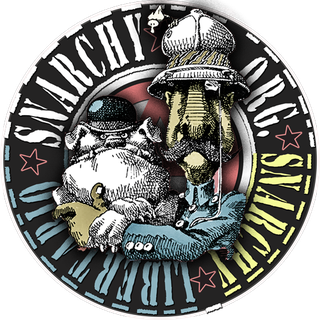
In a series of strange coincidences, we have managed to locate some Nazi ingots.

Over the last five years, the public imagination has been ablaze with intriguing stories of a hunt for a supposed Nazi gold train crammed with 300 tonnes of bullion. In 1945 the Nazis had embarked on a vast underground infrastructure venture know as Project Riese (‘Giant’) in south east Poland. The works involved the development of seven underground complexes which were subsequently to be connected by light-gauge railway. The huge project, built largely by POWs and occupants of the concentration camps, was never completed and its final aim was never clearly established as most of the documentation has been lost. Parts of the unfinished network of steel and concrete-reinforced underground tunnels and structures remain to this day.
The legend goes that that a bullion and jewel-laden train had been buried there by the German high command. In recent times, treasure hunters with ever more sophisticated radar and detection equipment began to search the area. The (probably apocryphal) story was given further credence when a Polish minister claimed to have ground penetrating radar images of what appeared to be a train. By 2015, the site was taking on Loch Ness proportions, eventually forcing local authorities to call in the army to cordon off the zone and conduct their own official search for the Nazi Nessie.

But alas, no train or tracks were ever discovered.
Nazi gold most certainly did exist however. And some of it still does.
Most German gold by now has been melted down and recycled. Given gold’s rarity and its highly-coveted nature, just about every nugget ever extracted from the earth is still accounted for in some form or other, whether it be in a jewellery box, a bank deposit box or in a vault at Fort Knox. Most gold mined by the Romans, for instance, still exists but would have undergone innumerable transformations, perhaps having been minted into coins, which could then have become wedding rings, ornaments, jewellery, ingots, industrial tools or any one of a thousand other applications.
Yet since the turn of the century and the huge price spike brought on by the 2008 panic, the trend for gold transmogrification has been a very uniform one. Gold shops, jewellers and dealers sell almost everything – bar some precious numismatic rarities – as scrap metal.
As we live on the Swiss - Italian border, there is plenty of access to first-hand information on how the gold recycling process goes. Italian scrap gold, for example, irrespective of its format, for the most part, ends up transported across the border to local Swiss refineries where it is then re-crafted into the popular China-friendly one kilo bars. Nowadays repackaged European gold almost always goes East to satisfy the insatiable Chinese appetite for the metal.

Economist and lawyer Jim Rickards, an authority on gold, recently gave an insight into how Swiss refineries function:
The Swiss information gives us a window on the world. That’s because Swiss imports and exports are mostly about the Swiss refining business, which is the largest in the world. There are no major gold mines in Switzerland and Swiss citizens are not known as major buyers of gold (unlike, say, Chinese or Indian citizens). The Swiss watch industry does use a lot of gold, but imports are balanced out by exports; Switzerland itself is not a major destination for Swiss watches.
In effect, Switzerland is a conduit for much of the gold in the world. Gold arrives in Switzerland as 400-ounce good delivery bars, doré bars (those are 80% pure ingots from gold miners), and “scrap” (that’s the term for jewellery and other recycled gold objects).
This gold is then melted down and refined mostly into 99.99% pure 1-kilo gold bars, worth about $45,000 each at current market prices. These 1-kilo “four nines” quality bars are the new global standard and are the ones most favoured by the Chinese.
Rickards then goes on to explain that the gold stock in storage in Swiss refineries are running so low that some of the serial numbers on ingots date back decades.
Rickards states, ‘A gold refiner in Switzerland told me, “Jim, if you called to buy gold and I did not know you personally, I would not even return the call. We have none available.”
Well, we can further expand upon that claim. In a recent conversation with a friend of mine from the same region, the subject of dwindling gold supplies came up. I was very surprised to hear that my Italian friend had briefly worked in one of the top refineries across the border in Chiasso in the Swiss Ticino Canton. Quite taken aback at the news I quizzed him further and was shocked to hear that the refinery warehouse actually contained gold ingots emblazoned with the Nazi swastika!
(Note: While I can personally vouch for the trustworthiness of the source of information, it should be pointed out that there have been numerous cases of forged gold ingots. Several cases of duplicate serial numbers have come to light in recent years.)
But while the question of where Nazi gold is located appeals to our romantic fascination for adventure stories, it overshadows a far more interesting conundrum: Why did the Nazis give such importance to the yellow metal? The answer is as relevant today as during the war. One reason is because the British, like their German counterparts, ran vast currency counterfeiting operations with the intention of flooding foreign markets with bogus banknotes and thus devaluing enemy currencies and weakening their economies. You might think of this as Quantitative Easing... but QE where you print the enemy’s currency, not your own.

This sheds an interesting light onto the actions of our own central banks today, which for over a decade have been intent on counterfeiting their countries’ own currencies. The FED, the ECB and the BOE, to name just a few, have been very open about their attempts to stimulate inflation. Inflation is simply a tax on the country’s citizens. Today’s deflationary environment, likewise, means that having a steady income in a deflationary currency is akin to having a pay-rise in purchasing power every month… although they won’t tell you that on your neo-liberal economics course. Which is precisely why no central bank in the world wants deflation.
The Nazis were very aware of this and were simply hedging their bets in the knowledge that their own German mark had suffered a catastrophic hyper-inflation just twenty years earlier.
My advice would be the following: forget the gold treasure hunts and read a bit of economic history! Every crisis in history has ended in inflation. In today’s turbulent times with the world’s economy tanking, it might be a moment to consider reinforcing your own underground supply of gold and silver bullion. It doesn’t have to be Project Riese, but by the time the dust settles on the latest crisis and its subsequent heist, your hoard will have increased in value substantially.


Write a comment